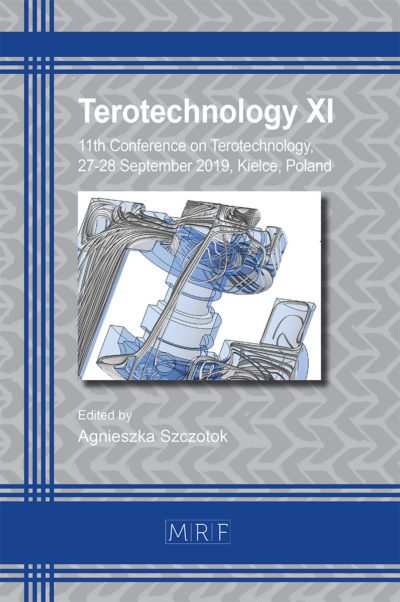Polymer-tool friction coefficient in temperature for thermoforming numerical simulation
CAUBET Benoit, LÉONARDI Frederic, AMAND Sylvain
download PDFAbstract. In this work, friction coefficient between Polycarbonate and Aluminum was measured over the entire thermoforming temperature range by using a rotational rheometer with a specific geometry, following the B. Hegemann et al. [1] method. The effects of velocity, pressure and surface roughness were investigated. Then, numerical simulation were performed using a finite element code package for thermoforming (T-SIM®) with K-BKZ viscoelastic model. The objective of this work is to find which friction coefficient use in T-SIM simulation to be as close as possible to reality. For this, numerical simulation results for different friction coefficient were compared with experimental values to evaluate the predictive capacity. It was shown that friction coefficient is temperature dependent and rapidly increase above glass transition of polycarbonate. At room temperature, friction coefficient increases with an increase in roughness, but after glass transition, trend is reversed. Simulations with measured friction coefficients shows good agreement with experiment data.
Keywords
Thermoforming, Friction Coefficient, Numerical Simulation, Thickness Distribution, T-SIM®, Polycarbonate
Published online 4/19/2023, 10 pages
Copyright © 2023 by the author(s)
Published under license by Materials Research Forum LLC., Millersville PA, USA
Citation: CAUBET Benoit, LÉONARDI Frederic, AMAND Sylvain, Polymer-tool friction coefficient in temperature for thermoforming numerical simulation, Materials Research Proceedings, Vol. 28, pp 1907-1916, 2023
DOI: https://doi.org/10.21741/9781644902479-206
The article was published as article 206 of the book Material Forming
![]() Content from this work may be used under the terms of the Creative Commons Attribution 3.0 license. Any further distribution of this work must maintain attribution to the author(s) and the title of the work, journal citation and DOI.
Content from this work may be used under the terms of the Creative Commons Attribution 3.0 license. Any further distribution of this work must maintain attribution to the author(s) and the title of the work, journal citation and DOI.
References
[1] Information on: Polymer_Polymeric_Hegemann2003_(methode par rhéo).pdf
[2] J.K. Lee, C.E. Scott, T.L. Virkler, Effects of rheological properties and processing parameters on ABS thermoforming, Polym. Eng. Sci. 41 (2001) 240-261. https://doi.org/10.1002/pen.10725
[3] M. Takaffoli, G. Hangalur, R. Bakker, N. Chandrashekar, Thermo-visco-hyperelastic behavior of polycarbonate in forming of a complex geometry, J. Manuf. Process. 57 (2020) 105-113. https://doi.org/10.1016/j.jmapro.2020.06.019
[4] J. Cha, H.Y. Song, K. Hyun, J.S. Go, Rheological measurement of the nonlinear viscoelasticity of the ABS polymer and numerical simulation of thermoforming process, Int. J. Adv. Manuf. Technol. 107 (2020) 2449-2464. https://doi.org/10.1007/s00170-020-04979-7
[5] P.J. Martin, R. McCool, C. Härter, H.L. Choo, Measurement of polymer-to-polymer contact friction in thermoforming, Polym. Eng. Sci. 52 (2012) 489-498. https://doi.org/10.1002/pen.22108
[6] D. Marathe, D. Rokade, L. Busher Azad, K. Jadhav, S. Mahajan, Z. Ahmad, S. Gupta, S. Kulkarni, V. Juvekar, A. Lele, Effect of Plug Temperature on the Strain and Thickness Distribution of Components Made by Plug Assist Thermoforming, Int. Polym. Process. 31 (2016) 166-178. https://doi.org/10.3139/217.3060
[7] R.A. Morales, M.V. Candal, O.O. Santana, A. Gordillo, R. Salazar, Effect of the thermoforming process variables on the sheet friction coefficient, Mater. Des. 53 (2014) 1097-1103. https://doi.org/10.1016/j.matdes.2013.08.009
[8] P. Collins, E.M.A. Harkin-Jones, P.J. Martin, The Role of Tool/Sheet Contact in Plug-assisted Thermoforming, Int. Polym. Process. 17 (2002) 361-369. https://doi.org/10.3139/217.1702
[9] A. Erner, Étude expérimentale du thermoformage assisté par poinçon d’un mélange de polystyrènes, p. 232.
[10] J. Voyer, S. Klien, I. Velkavrh, F. Ausserer, A. Diem, Static and Dynamic Friction of Pure and Friction-Modified PA6 Polymers in Contact with Steel Surfaces: Influence of Surface Roughness and Environmental Conditions, Lubricants 7 (2019) 17. https://doi.org/10.3390/lubricants7020017
[11] V. Quaglini, P. Dubini, D. Ferroni, C. Poggi, Influence of counterface roughness on friction properties of engineering plastics for bearing applications, Mater. Des. 30 (2009) 1650-1658. https://doi.org/10.1016/j.matdes.2008.07.025
[12] B. Briscoe, The friction of polymers : a short review, Proc. 7 th Leeds-Lyon Symposium of tribology, N° 00682, 1980, pp. 9-1281.
[13] E. Mitsoulis, 50 Years of the K-BKZ Constitutive Relation for Polymers, ISRN Polym. Sci. 2013 (2013) 1-22. https://doi.org/10.1155/2013/952379
[14] K. Landsecker, C. Bonten, Thermoforming simulation of heat conductive plastic materials using the K-BKZ model, presented at the Materials characterization using X-rays and related techniques, Kelantan, Malaysia, 2019, p. 030049. https://doi.org/10.1063/1.5088307
[15] S. aus der Wiesche, Industrial thermoforming simulation of automotive fuel tanks, Appl. Therm. Eng. 24 (2004) 2391-2409. https://doi.org/10.1016/j.applthermaleng.2004.03.003
[16] E.E. Marotta, L.S. Fletcher, Thermal contact conductance of selected polymeric materials, J. Thermophys. Heat Trans. 10 (1996) 334-342. https://doi.org/10.2514/3.792
































